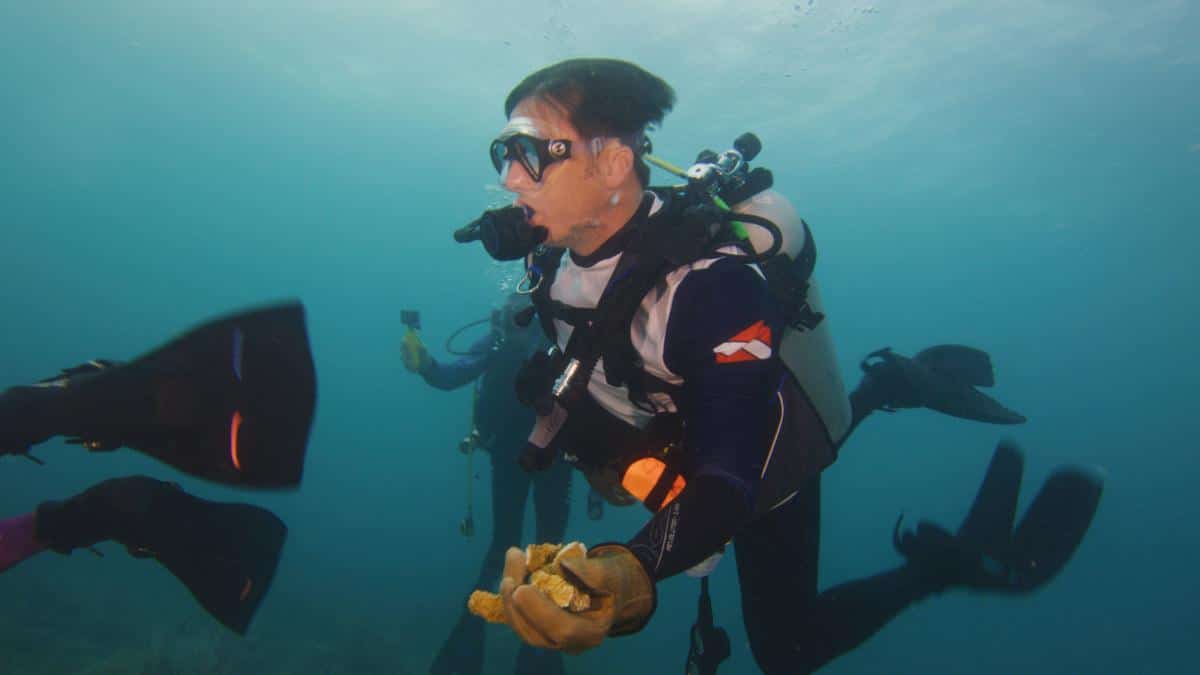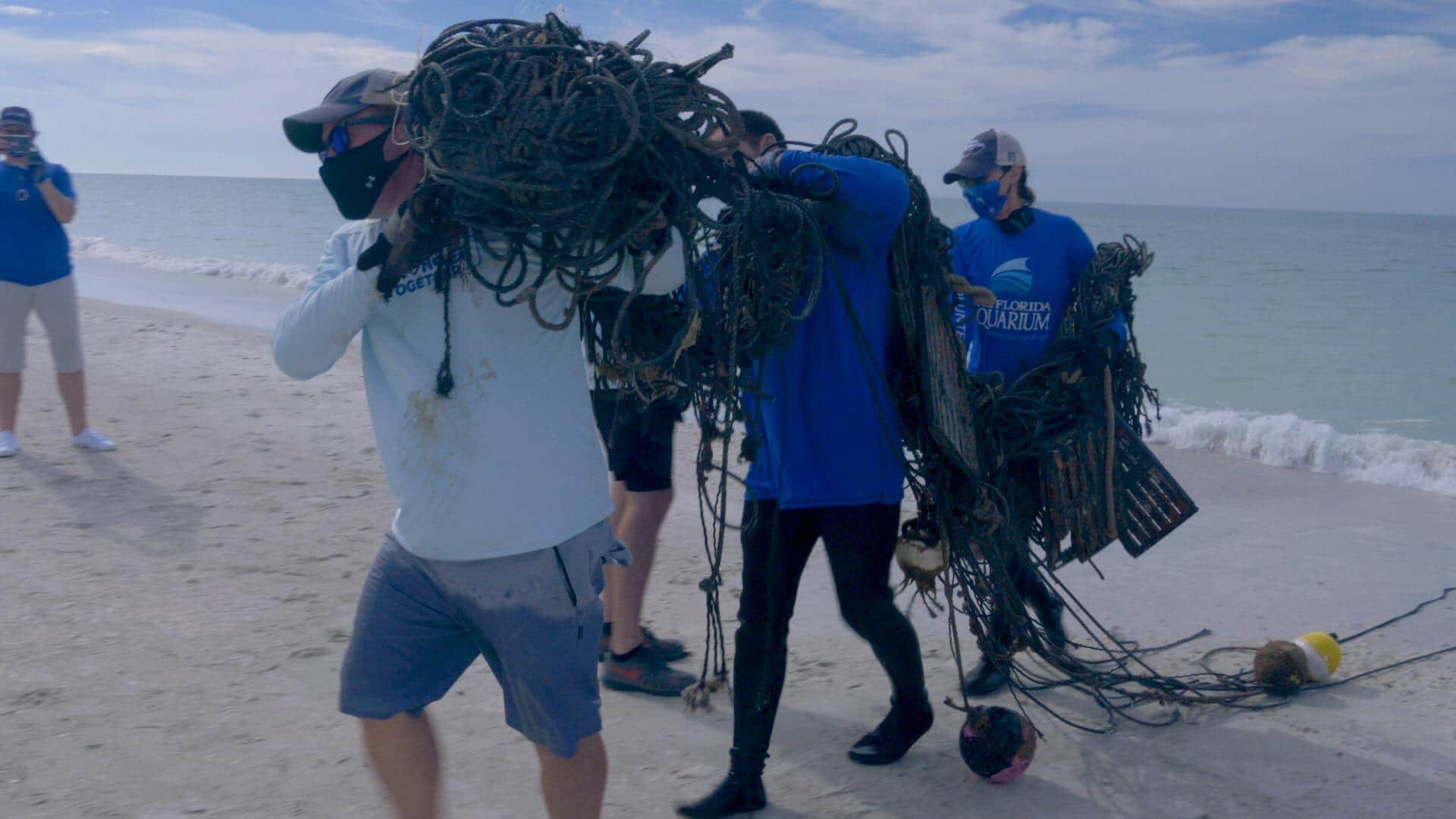
NFL Green Tackles Coral Restoration Project in Florida Ahead of Super Bowl LV

NFL Green, the NFL's environmental and sustainability program, helps to restore Florida's Coral Reef in Tampa ahead of the Super Bowl as part of its annual Green Week. Force Blue
When we think of the Super Bowl — America’s most popular sporting event, according to Arcadia Publishing — ocean conservation and military veterans usually aren’t top of mind. But, for the last two years, a unique collaboration ahead of the annual game has placed coral restoration at the forefront of the world’s attention.
For almost 30 years, NFL Green, the NFL’s environmental and sustainability program, has managed community greening initiatives for the sports league. Each season, these culminate with “Green Week” before the big event, with projects undertaken by the NFL and Super Bowl Host Committee benefitting each host community, explained NFL Green Associate Director Susan Groh.
“The goal of NFL Green is to reduce the environmental impact of our events and to go well beyond that to leave a positive green legacy,” Groh told EcoWatch. Efforts include recovering food, recycling and waste management, donating used event and building materials and offsetting energy for events.
This green legacy has also included a touch of blue in the last two years, meaning conservation efforts focused on the waters of host cities Miami in 2020 and now Tampa in 2021. Miami Green Week activities for Super Bowl LIV entailed planting 100 endangered staghorn corals in Biscayne Bay in honor of the NFL’s 100th season, Groh said.
In the past year, the effort expanded to “100 Yards of Hope,” a football field-sized coral restoration project. The end zones and center of the field-sized reef were placed in fall 2020, followed by divers planting thousands of staghorn and mountainous star corals from The Florida Aquarium (FLAQ), the University of Miami Rosenstiel School of Marine and Atmospheric Science SECORE International and Frost Science, explained FLAQ Senior Vice President of Conservation Debborah Luke.

Military veterans and coral scientists team up to outplant endangered corals as part of the NFL’s 100 Yards of Hope. Force Blue
“This critically important project is helping to restore Florida’s Coral Reef, the third-largest barrier reef in the world, which is in crisis,” Luke told EcoWatch.
Florida’s Coral Reef provides key nursery areas that support the oceanic ecosystem and protect coastlines from storms and erosion, Luke said. It also provides significant economic benefits by pumping .4 billion annually into the U.S. economy through jobs, tourism, seafood and medicine, NFL’s Groh added.
Unfortunately, global factors such as the climate crisis, ocean warming and acidification remain threats, along with regional pollutants and a mysterious coral disease.
“Over 90 percent of [the reef’s] corals have died… restoration of Florida’s Coral Reef is imperative if we are to continue reaping [its] benefits,” Luke said.
100 Yards of Hope intends to reverse this trajectory on a single showcase reef, explained Dalton Hesley, a senior research associate at the Rosenstiel School, whose team spearheaded restoration efforts. This is the first large-scale restoration project to combine thousands of sexual and asexual multi-species coral transplants, along with disease tracking and mitigation, urchin relocation and high-resolution mapping. These actions all increase coral cover, diversity and recovery, Hesley noted.
“100 Yards of Hope is a symbol. It is a symbol of what passionate, hopeful individuals can accomplish when working towards a shared vision,” Hesley told EcoWatch. “What started as a celebration of the NFL’s 100th season has transformed into a fight for the future of our coral reef.”
Last week, 150 elkhorn corals, another threatened coral species, were added to the field. The Rosenstiel School provided 55 of the endangered corals, in celebration of Super Bowl 55, this past weekend. FLAQ provided the remaining corals. A final planting of massive brain and star corals in the spring will complete 100 Yards of Hope, Groh said.
Military combat veterans from Force Blue assisted with the plantings. The nonprofit retrains and deploys former special operations veterans and military-trained combat divers to work alongside scientists and environmentalists on marine conservation work, explained Executive Director Jim Ritterhoff.

55 divers remove marine debris from Tampa Bay as part of the NFL’s Green Week. Force Blue
“If we can do something good for veterans by giving them a new mission to save the planet and provide a highly skilled workforce to the scientific community, all the better,” Ritterhoff said. “But, maybe the [touchdown] of it all is how this effort uses Navy SEALS and the NFL, people you don’t traditionally see talking about conservation, to reach an audience who wouldn’t necessarily pay attention to coral reef scientists. People listen because these guys are their heroes.”
Noting that this is more of a world project than a local Florida project, Ritterhoff added, “I think it’s imperative that everyone be cognizant of these issues. The Florida Coral Reef is a national treasure, and it could be 100 percent gone in our lifetime. If we don’t behave differently, it will be gone.”

NFL Green Week included planting the Reed Park community garden in Tampa Bay. Michael Farrant / Tampa Bay Super Bowl LV Host Committee
In addition to the coral restoration efforts, NFL Green completed traditional community greening projects. These involved creating pollinator gardens, planting mangroves, restoring shoreline and adding sand dunes to prevent erosion and storm damage.
NFL Green also connected land and sea with an underwater cleanup called Dive 55 at the mouth of Tampa Bay. For this, Force Blue team leaders led 55 divers to retrieve more than 1.5 tons of waste, not limited to old fishing traps, rope, netting, plastics and beach debris, Groh said. Some of the recovered items will be used by local students to create art projects that will be displayed at FLAQ to increase marine debris awareness.
“It’s all about leadership and legacy,” Groh said. “Large events have an opportunity to not only offset the environmental impact of their events but to go well beyond that and leave the communities hosting events better than they found them. The world faces significant environmental challenges and it’s going to take all of us to address them.”
- Coral in Crisis: Can Replanting Efforts Halt Reefs' Death Spiral ...
- First-Ever Aerial Map of Hawaii's Coral Creates Groundbreaking ...
- This Underwater Sculpture Is Helping to Restore Coral Reefs in ...
- Sea Turtles in the Florida Keys Have High Tumor Rates. Are Humans to Blame?
- Meet 'Sponge Bobbie,' the Marine Biologist Using Sponges to Save Coral Reefs

 233k
233k  41k
41k  Subscribe
Subscribe 